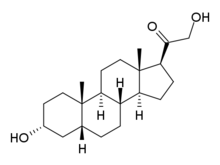Tetrahydrodeoxycorticosterone
Jump to navigation
Jump to search
 | |
| Clinical data | |
|---|---|
| Other names | THDOC |
| Identifiers | |
| |
| CAS Number | |
| PubChem CID | |
| UNII | |
| ECHA InfoCard | 100.008.457 |
| Chemical and physical data | |
| Formula | C21H34O3 |
| Molar mass | 334.500 g·mol−1 |
| 3D model (JSmol) | |
| |
| (verify) | |
Tetrahydrodeoxycorticosterone (abbreviated as THDOC; 3α,21-dihydroxy-5α-pregnan-20-one), also referred to as allotetrahydrocorticosterone, is an endogenous neurosteroid.[1] It is synthesized from the adrenal hormone deoxycorticosterone by the action of two enzymes, 5α-reductase type I and 3α-hydroxysteroid dehydrogenase.[2] THDOC is a potent positive allosteric modulator of the GABAA receptor, and has sedative, anxiolytic and anticonvulsant effects.[3][4][5] Changes in the normal levels of this steroid particularly during pregnancy and menstruation may be involved in some types of epilepsy (catamenial epilepsy) and premenstrual syndrome,[6] as well as stress, anxiety and depression.[7][8][9][10][11]
Chemistry
See also
References
- ^ Hosie AM, Wilkins ME, da Silva HM, Smart TG (November 2006). "Endogenous neurosteroids regulate GABAA receptors through two discrete transmembrane sites". Nature. 444 (7118): 486–9. Bibcode:2006Natur.444..486H. doi:10.1038/nature05324. PMID 17108970. S2CID 4382394.
- ^ Agís-Balboa RC, Pinna G, Zhubi A, Maloku E, Veldic M, Costa E, Guidotti A (September 2006). "Characterization of brain neurons that express enzymes mediating neurosteroid biosynthesis". Proceedings of the National Academy of Sciences of the United States of America. 103 (39): 14602–7. Bibcode:2006PNAS..10314602A. doi:10.1073/pnas.0606544103. PMC 1600006. PMID 16984997.
- ^ Kokate TG, Svensson BE, Rogawski MA (September 1994). "Anticonvulsant activity of neurosteroids: correlation with gamma-aminobutyric acid-evoked chloride current potentiation". The Journal of Pharmacology and Experimental Therapeutics. 270 (3): 1223–9. PMID 7932175.
- ^ Reddy DS, Rogawski MA (May 2002). "Stress-induced deoxycorticosterone-derived neurosteroids modulate GABA(A) receptor function and seizure susceptibility". The Journal of Neuroscience. 22 (9): 3795–805. doi:10.1523/JNEUROSCI.22-09-03795.2002. PMC 6758375. PMID 11978855.
- ^ Reddy DS (2003). "Pharmacology of endogenous neuroactive steroids". Critical Reviews in Neurobiology. 15 (3–4): 197–234. doi:10.1615/critrevneurobiol.v15.i34.20. PMID 15248811.
- ^ Tuveri A, Paoletti AM, Orrù M, Melis GB, Marotto MF, Zedda P, et al. (July 2008). "Reduced serum level of THDOC, an anticonvulsant steroid, in women with perimenstrual catamenial epilepsy". Epilepsia. 49 (7): 1221–9. doi:10.1111/j.1528-1167.2008.01555.x. PMID 18325018. S2CID 23596739.
- ^ Reddy DS (March 2003). "Is there a physiological role for the neurosteroid THDOC in stress-sensitive conditions?". Trends in Pharmacological Sciences. 24 (3): 103–6. doi:10.1016/S0165-6147(03)00023-3. PMID 12628349.
- ^ Reddy DS (2006). "Physiological role of adrenal deoxycorticosterone-derived neuroactive steroids in stress-sensitive conditions". Neuroscience. 138 (3): 911–20. doi:10.1016/j.neuroscience.2005.10.016. PMID 16325348. S2CID 23576732.
- ^ Eser D, Romeo E, Baghai TC, di Michele F, Schüle C, Pasini A, et al. (2006). "Neuroactive steroids as modulators of depression and anxiety". Neuroscience. 138 (3): 1041–8. doi:10.1016/j.neuroscience.2005.07.007. PMID 16310959. S2CID 12033307.
- ^ Eser D, Schüle C, Baghai TC, Romeo E, Rupprecht R (2006). "Neuroactive steroids in depression and anxiety disorders: clinical studies" (PDF). Neuroendocrinology. 84 (4): 244–54. doi:10.1159/000097879. PMID 17159334. S2CID 15711990.
- ^ Maguire J, Mody I (February 2007). "Neurosteroid synthesis-mediated regulation of GABA(A) receptors: relevance to the ovarian cycle and stress". The Journal of Neuroscience. 27 (9): 2155–62. doi:10.1523/JNEUROSCI.4945-06.2007. PMC 6673487. PMID 17329412.
Categories:
- Articles with short description
- Short description matches Wikidata
- ECHA InfoCard ID from Wikidata
- Articles without EBI source
- Chemical pages without ChemSpiderID
- Chemical pages without DrugBank identifier
- Articles without KEGG source
- Articles without InChI source
- Drugs missing an ATC code
- Drugs with no legal status
- Neurosteroids
- Anticonvulsants
- Hypnotics
- GABAA receptor positive allosteric modulators
- GABAA-rho receptor negative allosteric modulators
- Pregnanes
- All stub articles
- Steroid stubs